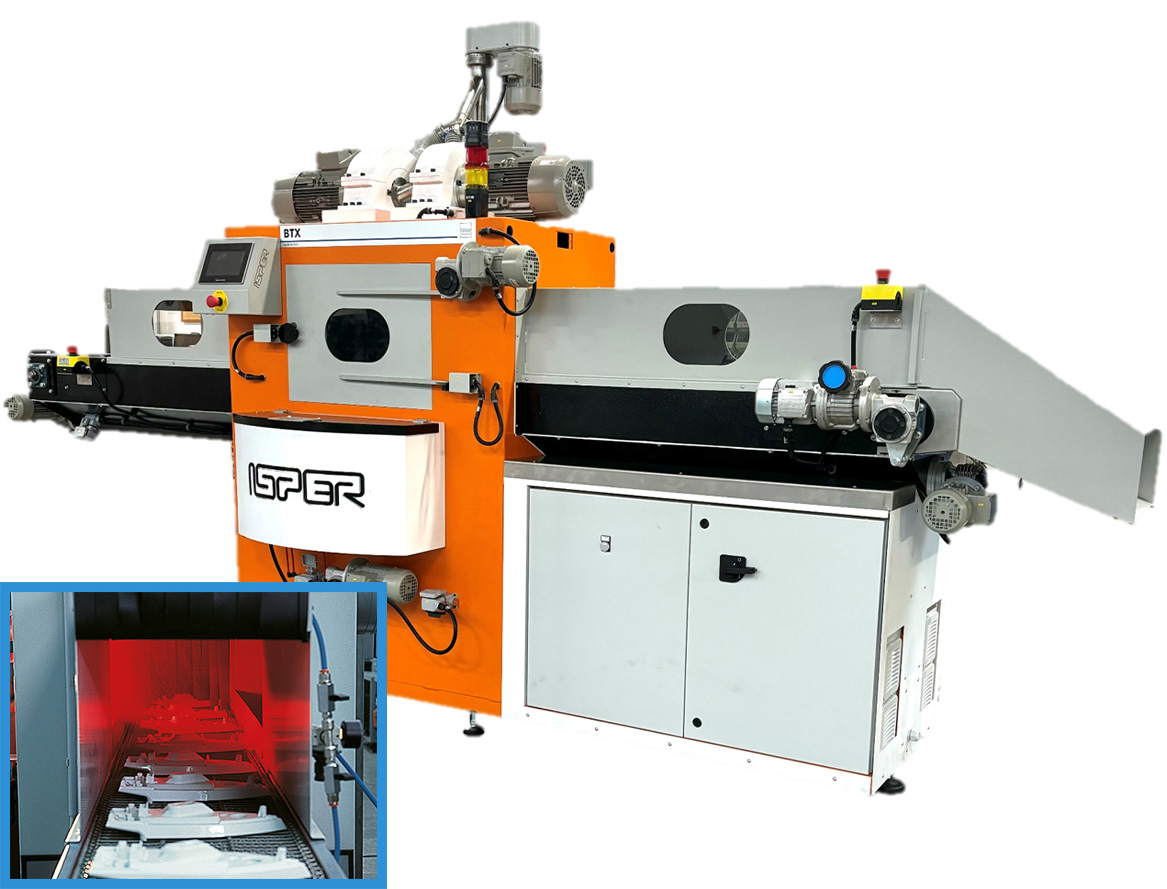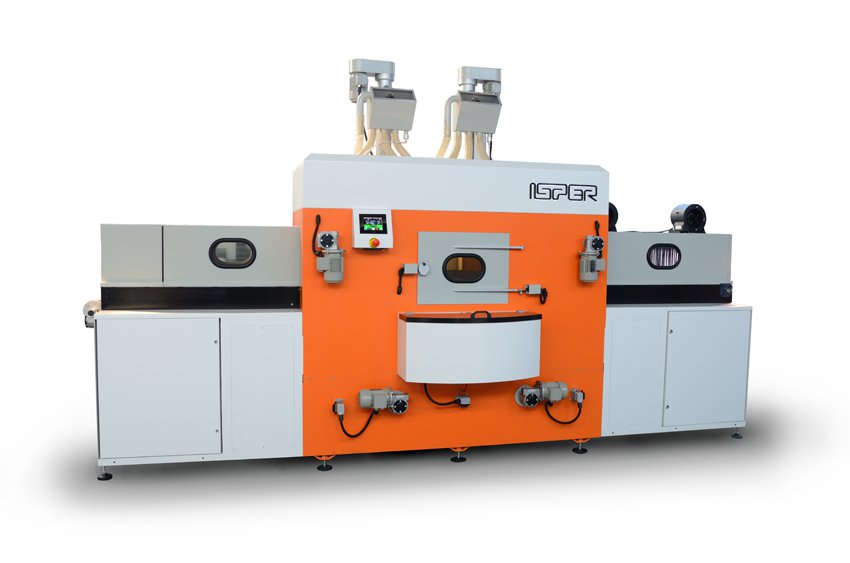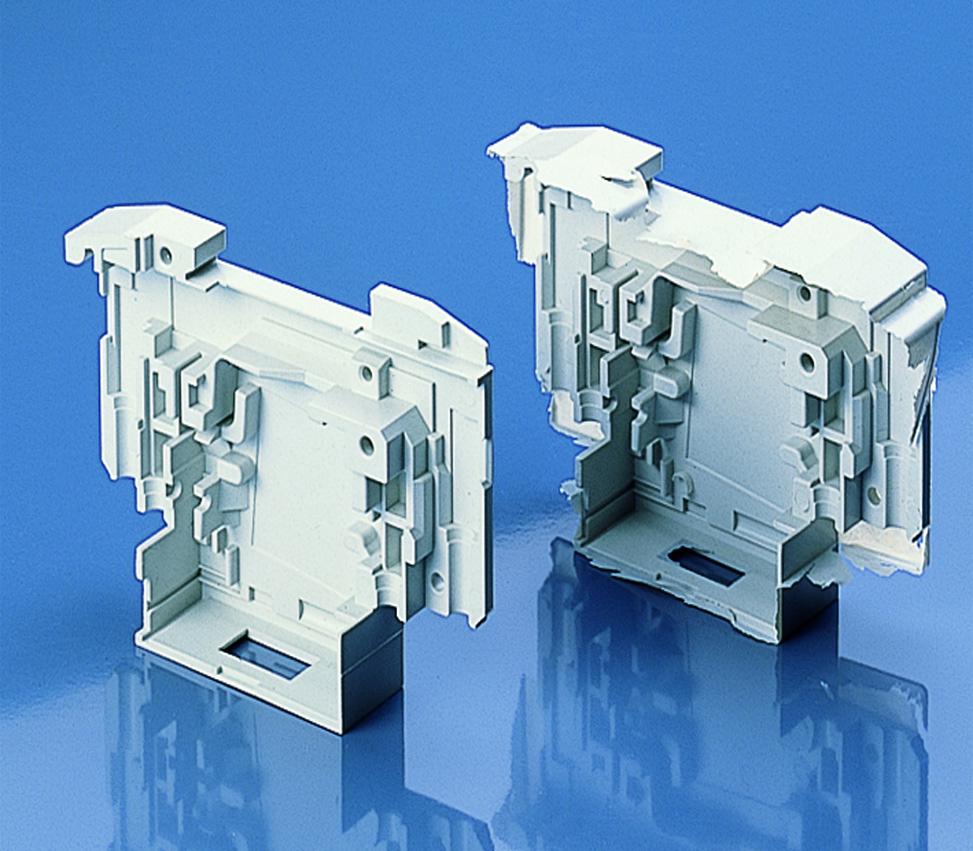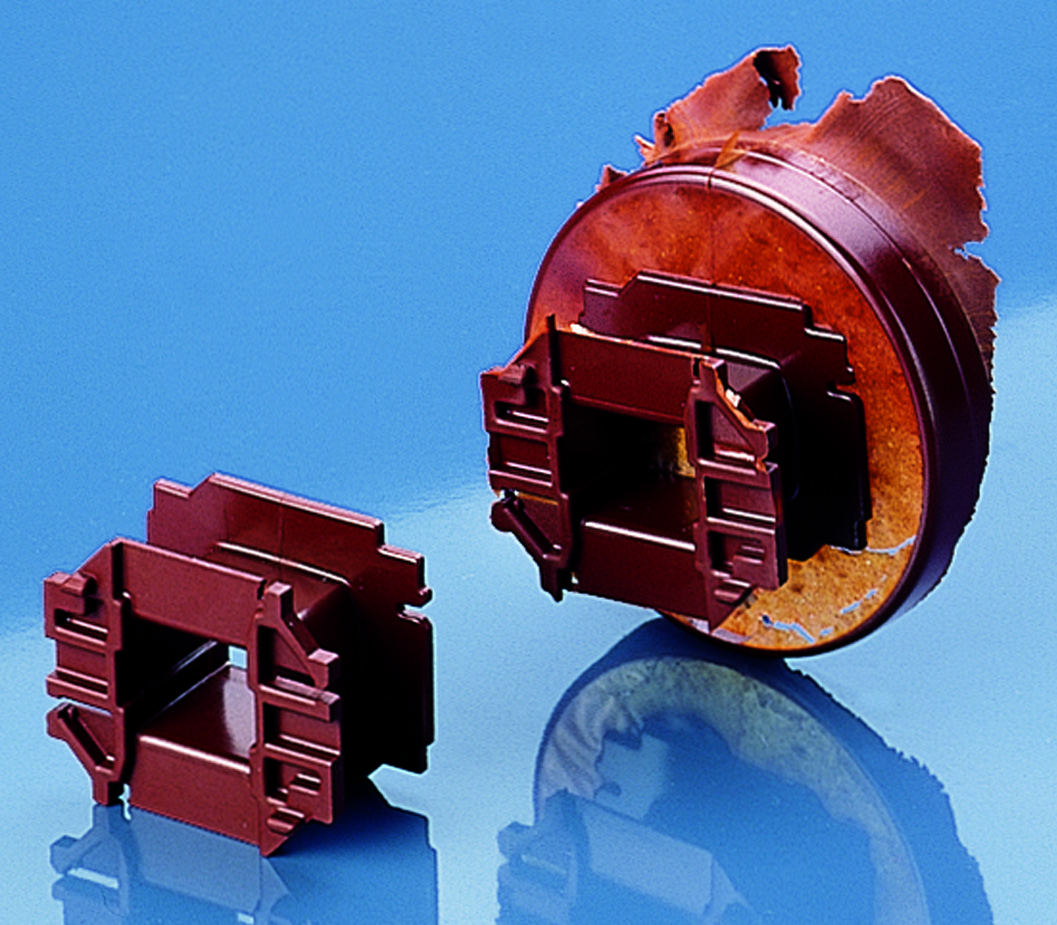Tech specs
Steelwire
Parts are conveyed through the deflashing machine on a continuos stainless steelwire mesh belt, which has large enough mesh to allow the deflashing media to pass easily through it. Two turbine impeller wheels, one in the upper part of the deflashing chamber and one located below the conveyor belt, propell Nylon grit at high speed toward the parts, providing simultaneous media impact
on flash located on both upper and lower surfaces; lateral impact is also achieved as a byeffect. The parts travel on the band at the desired speed from the loading area through the deflashing chamber and out to the discharge point.
Clean
Media velocity is controlled by vari-speed drives of the turbines. Media size is available from 0,5 to 2 mm in either cubic or cylindrical shape. The wire
mesh conveyor belt has a vari-speed drive to provide the required deflashing residence time for parts passing through the chamber.
Air-jets
Residual dust and media left in recesses of the parts are removed by air-jets positioned above the belt, outside the deflashing chamber, near the exit point. If all the media cannot be removed by these air-jets, the mouldings can be down-loaded into an in-line rotating cleaning drum, provided that they
will not be damaged in the process.
Little media loss
To minimize operational noise and keep media loss to pratically zero, retainer barriers have been built into the machine at both entry and exit ends; these two issues have been an ongoing problem with conveyor deflashing machines previously available to industry.
Dust collector
A negative pressure, self-cleaning dust collector removes dust from the deflashing
chamber. The media that collects at the bottom is conveyed by an auger
screws system and recycled back to the upper and lower turbines. Large pieces
of flash are continuously separated from the media through an automatic sieve
and discharged to the outside of the machine. To prevent the build-up of static charges on the media and on the parts, anti-static liquid is automatically metered into the grit as it is propelled through the turbines.
Mouldings can be placed by hand or by robot onto the wire mesh conveyor
belt at the “entrance” of the machine. After being deflashed, the parts are discharged through a covered slide-chute.
BTX deflashing machine
The BTX provides the answer for high production throughput rates for the deflashing of large or delicate moulded components which would be damaged if subjected to “bulk” deflashing methods. The BTX is the right machine for mouldings of long length; parts with many brittle details, that can not bang against each other, with high aesthetical requirements, are also ideal candidates for this deflashing machine, as well as for all those with burrs arranged mainly parallel to a surface of possible support.
TSX Deflashing Machine
The TSX and the COMPACT are automatic deflashing machines for continuous operation, particularly studied for the treatment of technical items with complicate shape and with delicate details. The machines comprehend feeding conveyor, deflashing chamber, grit recovery compartment, flash/grit separator, air suction and filtration plant. The deflashed parts fall down at the end of the grit recovery section. On the TSX both the feeding conveyor and the grit recovery compartment can be independently positioned in a straight line with the main axis of the deflashing chamber or perpendicularly, making it possible to adapt the configuration of the machine to the workshop available space.
Tech specs
Grit Recovery
On the COMPACT the grit recovery compartment is fix at 90° with the deflashing drum. The COMPACT requires the minimum space and fits easily
into a production unit together with moulding machines. This minimizes
manpower and internal transports for the best economy.
Speed
The feeding conveyor has a ribbed belt that lifts the parts in bulk into the
loading hopper. It is completely enclosed and its speed is continuously adjustable.
Grit stream
From the hopper the parts are transferred to the deflashing chamber
by an adjustable linear vibrator that drives them into the rotating drum.
This is cylindrical, made out of stainless steel net, and slopes forward in order
to move slowly the parts ahead while rotating; their movement can be affected
by rubber pegs that one can fix in the net on the base of empirical
observations. While the parts roll and tumble in the drum, the grit stream from the impeller hits them on the whole surface. This method employs only
20-30% of the power required by a pneumatic system.
Drum
The drum can rotate continuously, at intermittence and even with reversal,
setting the relevant timer controls on the electric cabinet. The grit and the large flashes gather at the chamber bottom. The small flashes and powders
are sucked away through a rotating self cleaning stainless steel filter to the air
filter with dust collector. The grit is depurated of the flash pieces and moved up again to the impeller by an auger system. The grit stream can be given different directions over the deflashing drum and the impeller speed can be adjusted continuously as the drive is a frequency converter.
Granules
A very tiny quantity of surfactant chemical in water solution is introduced at
regular intervals in the impeller housing by an automatic dosing pump;
this maintains the necessary humidity to avoid electrostatic charges and keep the granules from sticking to the parts surfaces. Parts get out perfectly clean
from dust.
Tech specs
Grit stream
From the hopper the parts are transferred to the deflashing chamber by an adjustable linear vibrator that drives them into the rotating drum.
This is cylindrical, made out of stainless steel net, and slopes forward in order to move slowly the parts ahead while rotating; their movement can be affected
by rubber pegs that one can fix in the net on the base of empirical observations. While the parts roll and tumble in the drum, the grit stream
from the impeller hits them on the whole surface. This method employs only 20-30% of the power required by a pneumatic system.
Drum
The drum can rotate continuously, at intermittence and even with reversal,
setting the relevant timer controls on the electric cabinet. The grit and the
large flashes gather at the chamber bottom. The small flashes and powders
are sucked away through a rotating self cleaning stainless steel filter to the air
filter with dust collector. The grit is depurated of the flash pieces and moved up again to the impeller by an auger system. The grit stream can be given
different directions over the deflashing drum and the impeller speed
can be adjusted continuously as the drive is a frequency converter.
Automatic dosing pump
A very tiny quantity of surfactant chemical in water solution is introduced at regular intervals in the impeller housing by an automatic dosing pump;
this maintains the necessary humidity to avoid electrostatic charges and keep the granules from sticking to the parts surfaces. Parts get out perfectly clean from dust.
Grit removal compartment
The grit removal compartment is also equipped with a stainless net rotary drum; the parts get reed of the grit granules and proceed to the exit, while the incoming air stream traps in the granules that fall down to be recycled.
COMPACT Deflashing Machine
On the COMPACT the grit recovery compartment is fix at 90° with the deflashing drum. The COMPACT requires the minimum space and fits easily into a production unit together with moulding machines. This minimizes manpower and internal transports for the best economy.The feeding conveyor has a ribbed belt that lifts the parts in bulk into the loading hopper. It is completely enclosed and its speed is continuously adjustable.
Deflashing Machine TSX Batch
This machine combines the great reliability, consolidated over the years, of the mod. TSX deflashing machine, the possibility of working even in batches, which, with a dedicated pneumatic cycle, through a system of opening and closing of special shutters, can be kept separate from each other.
Compared to the Compact model, this model having a larger diameter (230mm) deflashing cage and being longer also makes it possible to deflash larger pieces and in any case a prolonged stay of the pieces under grit shot.
Compared to a belt machine, the deflashing by TSX and Compact machines is particularly suitable for non-fragile pieces that can collide with each other without problems, indeed benefiting from the contact in a sort of tumbling.
Tech specs
Grit Recovery
On the COMPACT the grit recovery compartment is fix at 90° with the deflashing drum. The COMPACT requires the minimum space and fits easily
into a production unit together with moulding machines. This minimizes
manpower and internal transports for the best economy.
Speed
The feeding conveyor has a ribbed belt that lifts the parts in bulk into the
loading hopper. It is completely enclosed and its speed is continuously adjustable.
Grit stream
From the hopper the parts are transferred to the deflashing chamber
by an adjustable linear vibrator that drives them into the rotating drum.
This is cylindrical, made out of stainless steel net, and slopes forward in order
to move slowly the parts ahead while rotating; their movement can be affected
by rubber pegs that one can fix in the net on the base of empirical
observations. While the parts roll and tumble in the drum, the grit stream from the impeller hits them on the whole surface. This method employs only
20-30% of the power required by a pneumatic system.
Drum
The drum can rotate continuously, at intermittence and even with reversal,
setting the relevant timer controls on the electric cabinet. The grit and the large flashes gather at the chamber bottom. The small flashes and powders
are sucked away through a rotating self cleaning stainless steel filter to the air
filter with dust collector. The grit is depurated of the flash pieces and moved up again to the impeller by an auger system. The grit stream can be given different directions over the deflashing drum and the impeller speed can be adjusted continuously as the drive is a frequency converter.
Granules
A very tiny quantity of surfactant chemical in water solution is introduced at
regular intervals in the impeller housing by an automatic dosing pump;
this maintains the necessary humidity to avoid electrostatic charges and keep the granules from sticking to the parts surfaces. Parts get out perfectly clean
from dust.
Deflashing Machine TSX MINI
This machine links TSX Batch model features with minimum room: it allows to work in batches with pneumatically operation cycle, dedicated, through special opening and closing shutters system; all this has 1800x1400 mm plan and 2600 mm height.
It is suitable both for a workshop layout and for in line positioning directly to moulding machine, increasing significantly production efficiency process.















